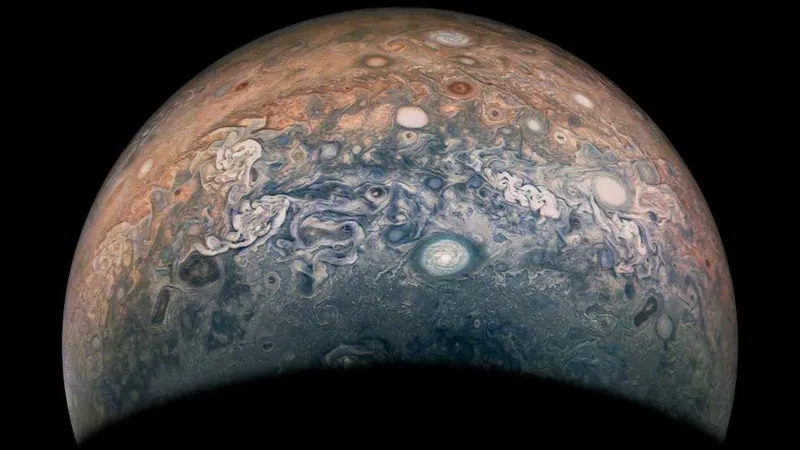
Stunning New Images of Jupiter's Storms and its "Potato" Moon Amalthea Captured by NASA's Juno Probe!
2024-11-11
Author: Li
Introduction
NASA's Juno spacecraft continues to mesmerize the world with its latest breathtaking images of Jupiter and its intriguing moon, Amalthea. During its 66th close flyby—also known as a perijove—on October 23, Juno brushed past the giant planet's poles and came close to Amalthea, revealing never-before-seen details of Jupiter's tumultuous atmosphere.
JunoCam's Captivating Images
Utilizing its powerful JunoCam, the spacecraft snapped raw images, which were later enhanced by a community of citizen scientists. These dedicated enthusiasts used color-enhancing filters to bring out the vivid hues and chaotic patterns of Jupiter's clouds, demonstrating the planet's atmospheric dynamics and the swirling storms that have fascinated astronomers for decades.
Dazzling Features Captured
The processed images showcase extraordinary features such as colorful bands and spiraling clouds, as well as intense vortices of varying sizes. Notably, one image captured by citizen scientist Jackie Branc reveals a Folded Filamentary Region (FFR) near Jupiter's subpolar latitudes—a spectacle of billowing, white clouds intertwined with delicate filaments that characterize the planet's active and chaotic weather systems.
Exploring Amalthea
But the excitement doesn't stop there! Juno also captured stunning images of Amalthea, a small moon with a unique 'potato' shape, measuring just 52 miles (84 kilometers) in radius. This makes Amalthea significantly smaller than Earth's moon. Citizen scientist Gerald Eichstädt enhanced a picture of Amalthea, brightening the image to distinguish the moon against the vast, dark tapestry of space.
Juno's Ongoing Mission
Since its arrival in orbit around Jupiter in July 2016, Juno has been on a quest to uncover secrets about the gas giant. The spacecraft has extended its mission beyond the original end date of July 2021 and is now in its final year of observations. Mark your calendars—Juno is scheduled for a dramatic conclusion as it will plunge into Jupiter's atmosphere in September 2025, where it will burn up, closing its historic mission.
Conclusion
These extraordinary images and findings remind us just how vibrant and dynamic our solar system's largest planet is, continuing to ignite interest and excitement in the realm of space exploration. Stay tuned for more astonishing revelations from Juno!

 Brasil (PT)
Brasil (PT)
 Canada (EN)
Canada (EN)
 Chile (ES)
Chile (ES)
 España (ES)
España (ES)
 France (FR)
France (FR)
 Hong Kong (EN)
Hong Kong (EN)
 Italia (IT)
Italia (IT)
 日本 (JA)
日本 (JA)
 Magyarország (HU)
Magyarország (HU)
 Norge (NO)
Norge (NO)
 Polska (PL)
Polska (PL)
 Schweiz (DE)
Schweiz (DE)
 Singapore (EN)
Singapore (EN)
 Sverige (SV)
Sverige (SV)
 Suomi (FI)
Suomi (FI)
 Türkiye (TR)
Türkiye (TR)